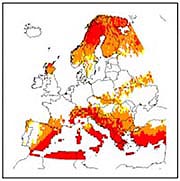
Predictions of changes in river runoff patterns in Europe due to climate change. The red and orange regions represent areas where the changes due to global warming will be significant (From: Hulme et al., 1999).
 Predictions of changes in river runoff patterns in Europe due to climate change. The red and orange regions represent areas where the changes due to global warming will be significant (From: Hulme et al., 1999). |